RECOMMENDED READING
totenkopf: CHARLES TRANG
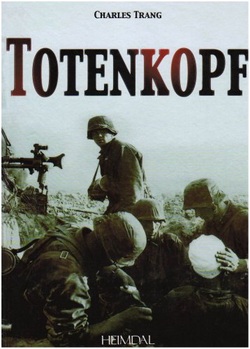
The author traces here the complete record of this SS armored division which was originally composed of concentration camp guards.
The Totenkopf fought first in France in 1940 and was then sent to the eastern front from 1941 - 1945. There it was engaged in some of the most ferocious battles, Kharkov, Kursk, Warsaw and Vienna being the most famous.
This fanatical division's history is littered with atrocities, the most famous being the massacre of British prisoners at Paradise Farm.
In the book you will find a complete itinerary for the division during its service in France, detailed accounts of all the atrocities, eyewitness accounts of actual witnesses that crossed its path, testimonies of veterans of the campaigns on the Eastern Front and finally, a complete organization chart of the division with all the regimental and battalion commanders.
This detailed text is accompanied by an astonishing collection of some 800 photographs.
The Totenkopf fought first in France in 1940 and was then sent to the eastern front from 1941 - 1945. There it was engaged in some of the most ferocious battles, Kharkov, Kursk, Warsaw and Vienna being the most famous.
This fanatical division's history is littered with atrocities, the most famous being the massacre of British prisoners at Paradise Farm.
In the book you will find a complete itinerary for the division during its service in France, detailed accounts of all the atrocities, eyewitness accounts of actual witnesses that crossed its path, testimonies of veterans of the campaigns on the Eastern Front and finally, a complete organization chart of the division with all the regimental and battalion commanders.
This detailed text is accompanied by an astonishing collection of some 800 photographs.
SS-TOTENKOPF, THE HISTORY OF THE "DEATH'S HEAD" DIVISION. 1940-1945: CHRIS MANN
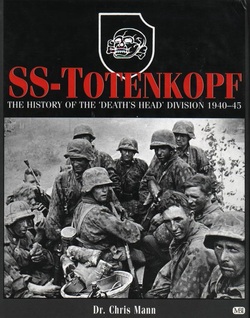
This military history examines one of the most famous of the Waffen-SS divisions, the "Death's Head".
The author describes the formation of the division, its men and officers, as well as uniform and insignia, and provides a full combat record.
The author describes the formation of the division, its men and officers, as well as uniform and insignia, and provides a full combat record.
LIKE A CLIFF IN THE OCEAN: KARL ULLRICH
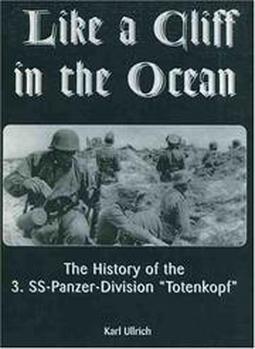
Hard cover, large format (9" x 12"), 327 pages, 27 pages of color maps and 20 plus black and white maps (most full page), 120+ photos.
This is the one-volume text history of the division that was written by Karl Ullrich, a Knight's Cross recipient and commander in the division. The text is about 50% standard unit history and 50% first-person accounts.
Although there are several English-language accounts of this SS division (many of dubious quality), this is the first one available that was written from the perspective of the division itself.
The book covers the formation of the division in 1939 and its subsequent operations during the Second World War. With the exception of the French Campaign in 1940, the division fought entirely on the Eastern Front and earned a reputation as one of the most capable divisions of the entire Eastern Army, especially in defense.
This is the one-volume text history of the division that was written by Karl Ullrich, a Knight's Cross recipient and commander in the division. The text is about 50% standard unit history and 50% first-person accounts.
Although there are several English-language accounts of this SS division (many of dubious quality), this is the first one available that was written from the perspective of the division itself.
The book covers the formation of the division in 1939 and its subsequent operations during the Second World War. With the exception of the French Campaign in 1940, the division fought entirely on the Eastern Front and earned a reputation as one of the most capable divisions of the entire Eastern Army, especially in defense.
TOTENKOPF ARCHIVES: CHARLES TRANG
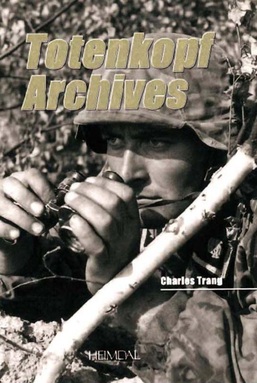
Charles Trang provides an indispensable supplement to his Totenkopf.
(out of print in French though still available in English).
This new album includes over 600 previously unpublished photos in addition to exceptional documentation.
(out of print in French though still available in English).
This new album includes over 600 previously unpublished photos in addition to exceptional documentation.
SOLDIERS OF DESTRUCTION: CHARLES SNYDOR
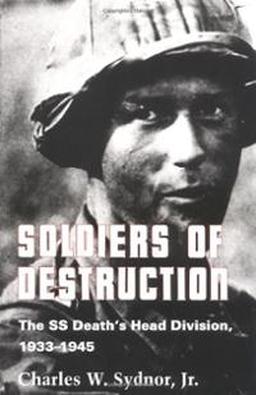
Soldiers of Destruction is a scholarly examination of the 3rd SS Panzer Division Totenkopf, perhaps the most controversial of all the SS divisions.
Dr. Charles Sydnor Jr. does an excellent job of tracing the origins of Totenkopf from its origins in the concentration camp system to crack fighting unit.
Dr. Syndor captures the facts regarding the effect that Theodor Eicke had on creating the division from his hand picked staffs in the concentration system. Thus creating a combat division led and manned by individuals already hardened to cruelty to the “enemy behind the wire”.
Syndor presents a detailed account of Eicke’s rise through the concentration camp system, his immense political connections, the origins of the Totenkopf division under Eicke’s guidance.
Dr. Charles Sydnor Jr. does an excellent job of tracing the origins of Totenkopf from its origins in the concentration camp system to crack fighting unit.
Dr. Syndor captures the facts regarding the effect that Theodor Eicke had on creating the division from his hand picked staffs in the concentration system. Thus creating a combat division led and manned by individuals already hardened to cruelty to the “enemy behind the wire”.
Syndor presents a detailed account of Eicke’s rise through the concentration camp system, his immense political connections, the origins of the Totenkopf division under Eicke’s guidance.
SS-TOTENKOPF IN FRANCE, CAMPAIGN PHOTO DIARY OF THE "TOTENKOPF" DIVISION, MAY 1940: ERIC LEFE'VRE
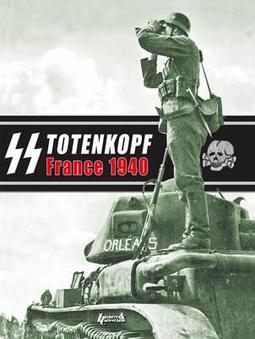
Published in 1942 with the title Damals, this album is aimed at enhancing the reputation of the SS-Totenkopf-Division, a rather unusual motorized Waffens-SS formation whose nucleus had been shaped with concentration camp guards, the sadly famous SS-Totenkopfverbande.
Evidence is provided through text and photos that in 1940, on the battlefields of France, this division displayed the same worth as the best Wehrmacht divisions.
Eric Lefe'vre has added a historical account of the unit and a biography of its commander SS-Gruppenfuhrer Eicke to the original facsimile.
Each of the 89 photos and each text forms the subject of remarks and necessary annotations by the same writer.
Eric Lefe'vre is a well-known specialist of the WWII German Amy.
Evidence is provided through text and photos that in 1940, on the battlefields of France, this division displayed the same worth as the best Wehrmacht divisions.
Eric Lefe'vre has added a historical account of the unit and a biography of its commander SS-Gruppenfuhrer Eicke to the original facsimile.
Each of the 89 photos and each text forms the subject of remarks and necessary annotations by the same writer.
Eric Lefe'vre is a well-known specialist of the WWII German Amy.
OPERATION BARABAROSSA, THE WAFFEN-SS IN COMBAT: CHARLES TRANG
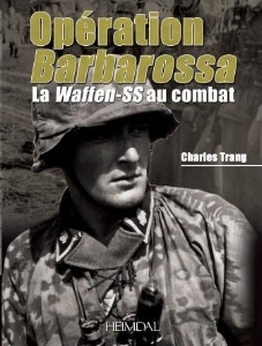
On June 22, 1941, the Axis forces invaded the Soviet Union. The biggest offensive of all time had just been launched.
Among the 3.5 million men lined up by the Wehrmacht for Operation Barbarossa, approximately one hundred thousand belonged to the Waffen-SS. While they represented a small percentage of troops, their role was proportionally greater than their numbers foreshadowed. Indeed, because of their power, the Leibstandarte, Reich, Totenkopf and Wiking divisions were employed within Panzergruppen, spearheads of the German offensive.
The Polizei-Division, although non-motorized, distinguished themselves by blowing up the Soviet lock on Louga. But alongside their solid training, the Waffen-SS units of weak value, such as the SS-Infantry-Regiment 9 (motorized) or the SS-Division Nord, whose combat performance was disappointing to say the least. Finally, one cannot ignore the actions of "cleansing" carried on the rear of the German armies by troops under the direct command of Himmler, namely SS-Brigade Kavallerie the 1.SS Infantry Brigade-(motorized) and 2.SS-Infantry Brigade (motorized). Their crimes were forever marked by the seal of infamy.
Among the 3.5 million men lined up by the Wehrmacht for Operation Barbarossa, approximately one hundred thousand belonged to the Waffen-SS. While they represented a small percentage of troops, their role was proportionally greater than their numbers foreshadowed. Indeed, because of their power, the Leibstandarte, Reich, Totenkopf and Wiking divisions were employed within Panzergruppen, spearheads of the German offensive.
The Polizei-Division, although non-motorized, distinguished themselves by blowing up the Soviet lock on Louga. But alongside their solid training, the Waffen-SS units of weak value, such as the SS-Infantry-Regiment 9 (motorized) or the SS-Division Nord, whose combat performance was disappointing to say the least. Finally, one cannot ignore the actions of "cleansing" carried on the rear of the German armies by troops under the direct command of Himmler, namely SS-Brigade Kavallerie the 1.SS Infantry Brigade-(motorized) and 2.SS-Infantry Brigade (motorized). Their crimes were forever marked by the seal of infamy.
SS-REGIMENT "THULE": CHARLES TRANG
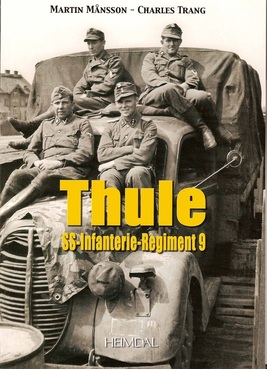
SS-Infanterie-Regiment Thule was stationed in Finland the majority of the war and fought along side SS-Nord.
In 1942, they were transferred to the SS-Division "Totenkopf" as Schnelle-Schutzen-Regiment "Thule" which was eventually dissolved and the men were used as replacements in the Division.
In this photo album book by Charles Trang he covers photographs of the Regiment from it's formation and service in Finland all the way until its transfer to the SS-Division "Totenkopf"
In 1942, they were transferred to the SS-Division "Totenkopf" as Schnelle-Schutzen-Regiment "Thule" which was eventually dissolved and the men were used as replacements in the Division.
In this photo album book by Charles Trang he covers photographs of the Regiment from it's formation and service in Finland all the way until its transfer to the SS-Division "Totenkopf"
FROM THE ARCTIC CIRCLE TO THE DON RIVER: SS-REGIMENT "THULE" 1940-1943: RICHARD LANDWEHR
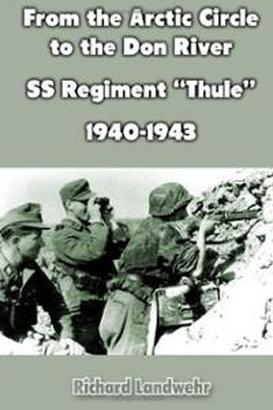
This is the first book to cover the story of the largely unheralded SS Regiment “Thule” in words and in pictures.
SS-Regiment “Thule” began as a battalion-sized security force in Norway in 1940 and ended up as the prototype for a “rapid light infantry” deployment force, about a half-century ahead of its time.
The intent in 1942 was to convey most of the “Thule” personnel either on motorcycles or in fast vehicles so that they could be sent rapidly to wherever they were most needed.
Unfortunately the debilitating battles around Kharkov in early 1943 put an end to this concept; the so-called “motorcycle-rifle” regiment became a luxury that the Waffen-SS could no longer afford. In this book you will get a glimpse of the impressive soldiers of SS Regiment “Thule” in training, at their barracks, in transit, in the field and in combat.
In the savage battle against Soviet communism they did their duty to the utmost and this volume will hopefully give some small inkling of their valor and sacrifice.
SS-Regiment “Thule” began as a battalion-sized security force in Norway in 1940 and ended up as the prototype for a “rapid light infantry” deployment force, about a half-century ahead of its time.
The intent in 1942 was to convey most of the “Thule” personnel either on motorcycles or in fast vehicles so that they could be sent rapidly to wherever they were most needed.
Unfortunately the debilitating battles around Kharkov in early 1943 put an end to this concept; the so-called “motorcycle-rifle” regiment became a luxury that the Waffen-SS could no longer afford. In this book you will get a glimpse of the impressive soldiers of SS Regiment “Thule” in training, at their barracks, in transit, in the field and in combat.
In the savage battle against Soviet communism they did their duty to the utmost and this volume will hopefully give some small inkling of their valor and sacrifice.
IN FINAL DEFENSE OF THE REICH: THE DESTRUCTION OF THE 6TH SS MOUNTAIN DIVISION "NORD": STEPHEN RUSIECKI

In April 1945 the American 71st Infantry Division exacted the final vestiges of life from the Reich's 6th SS Mountain Division in central Germany.
This analysis of the battle demonstrates that the Wehrmacht's last gasp on the Western Front was anything but a whimper, as some historians charge. Instead, Stephen Rusiecki argues, the Wehrmacht fought to extract every last bit of pain possible.
The book follows the histories of both the German and American divisions from their inception until their fateful confrontation in April 1945 and serves as a testament to the human experience in war, both from the perspective of the soldiers and from the civilians who suffered the brunt of the fighting.
This book is published in cooperation with the Association of the U.S. Army.
This analysis of the battle demonstrates that the Wehrmacht's last gasp on the Western Front was anything but a whimper, as some historians charge. Instead, Stephen Rusiecki argues, the Wehrmacht fought to extract every last bit of pain possible.
The book follows the histories of both the German and American divisions from their inception until their fateful confrontation in April 1945 and serves as a testament to the human experience in war, both from the perspective of the soldiers and from the civilians who suffered the brunt of the fighting.
This book is published in cooperation with the Association of the U.S. Army.
SEVEN DAYS IN JANUARY: WOLF T. ZOEPF
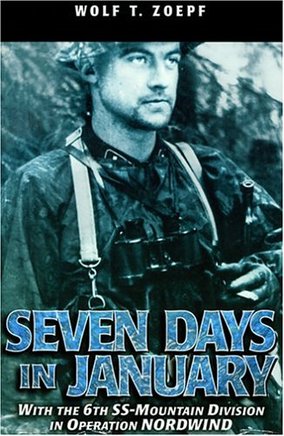
The first book-length account of the initial phase of Operation NORDWIND, the last German offensive on the Western Front in World War II, Seven Days in January is also a personal memoir by a key participant.
For perspective, the author includes a detailed, yet concise, summary of his division's operations during three years of combat against the Soviets on the Arctic Front near Murmansk, and its epic 1,000-mile fighting withdrawal across Finland and Norway after the Finns concluded a separate armistice with the USSR in 1944.
With this as background, the author focuses on a day-by-day description and analysis of Operation NORDWIND, based on not only his personal experience in the campaign, but on extensive use of both German and American archival sources and dozens of interviews with the combatants of both sides.
A gripping and detailed account of an important, yet until now obscure unit's participation in the last critical contest on the Western Front in WWII. Includes 36 highly-detailed maps, including eight textured 3-D maps derived from satellite imagery to facilitate the reader's fullest possible understanding of the terrain's effects on operations.
For perspective, the author includes a detailed, yet concise, summary of his division's operations during three years of combat against the Soviets on the Arctic Front near Murmansk, and its epic 1,000-mile fighting withdrawal across Finland and Norway after the Finns concluded a separate armistice with the USSR in 1944.
With this as background, the author focuses on a day-by-day description and analysis of Operation NORDWIND, based on not only his personal experience in the campaign, but on extensive use of both German and American archival sources and dozens of interviews with the combatants of both sides.
A gripping and detailed account of an important, yet until now obscure unit's participation in the last critical contest on the Western Front in WWII. Includes 36 highly-detailed maps, including eight textured 3-D maps derived from satellite imagery to facilitate the reader's fullest possible understanding of the terrain's effects on operations.
BLACK EDELWEISS: JOHANN VOSS
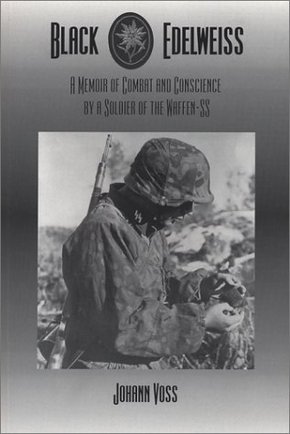
Originally written while the author was a prisoner of the US Army in 1945–46, Black Edelweiss is a boon to serious historians and WWII buffs alike. In a day in which most memoirs are written at half a century’s distance, the former will be gratified by the author’s precise recall facilitated by the chronologically short-range (a matter of one to seven years) at which the events were captured in writing. Both will appreciate and enjoy the abundantly detailed, exceptionally accurate combat episodes.Even more than the strictly military narrative, however, the author has crafted a searingly candid view into his own mind and soul. As such, Black Edelweiss is much more than a "ripping yarn" or a low-level military history. Black Edelweiss joins not only the growing body of German military memoirs, but the more select, more narrowly-focused group of personal memoirs by other Waffen-SSenlisted men. Beyond the microcosmic view of combat these books relate—to the extent that they are honest and candid—such books are important for what they can reveal about their authors’ motivations and reflections on those impulses and their consequences. To date, these works differ significantly.
As it joins the ranks of the books in this genre, Black Edelweiss makes a unique and very important contribution. It is a true, personal account of the author’s war years, first at school and then with the Waffen-SS, which he joined early in 1943 at the age of seventeen. For a year and a half, the author fought as a machine gunner in SS-Mountain Infantry Regiment 11 "Reinhard Heydrich," mainly in the arctic and sub-arctic reaches of Soviet Karelia and Finland, and later at the Western frontier of the Third Reich. The characters in the story are real, and the conversations and actions are recounted to the best of his ability from the short distance at which he wrote the manuscript in 1945–46.
Apart from the piercing insights into the question of why the German soldier fought as he did, what makes this book truly unique is the author’s anguished, yet resolute examination of the dialectic between the honorable and valorous comportment of his comrades and the fundamentally reprehensible conduct of about 35,000 men behind the front lines who nevertheless wore the same uniform.
During his captivity, the author was assigned for a time as a clerk to a US Army Judge Advocate General’s Corps officer, and in the performance of his administrative duties, the author had access to the mounting reams of documentation of the Holocaust. His growing recognition of the involvement of Waffen-SS personnel in the monstrous crimes of that process caused him to dig deeply into his soul, to examine his most intimate and private motivations and thoughts, and to reevaluate the most basic assumptions of his life to that point. The author captured this process and the result in the notes which became this book.
Honestly, forthrightly, and courageously told, Black Edelweiss is a precious gift to historians and other students of World War II. It not only provides a glimpse into the attributes that made the German armed forces a formidable and tenacious foe, but squarely confronts the most painful issue facing German World War II veterans in general, and Waffen-SS veterans in particular.
As it joins the ranks of the books in this genre, Black Edelweiss makes a unique and very important contribution. It is a true, personal account of the author’s war years, first at school and then with the Waffen-SS, which he joined early in 1943 at the age of seventeen. For a year and a half, the author fought as a machine gunner in SS-Mountain Infantry Regiment 11 "Reinhard Heydrich," mainly in the arctic and sub-arctic reaches of Soviet Karelia and Finland, and later at the Western frontier of the Third Reich. The characters in the story are real, and the conversations and actions are recounted to the best of his ability from the short distance at which he wrote the manuscript in 1945–46.
Apart from the piercing insights into the question of why the German soldier fought as he did, what makes this book truly unique is the author’s anguished, yet resolute examination of the dialectic between the honorable and valorous comportment of his comrades and the fundamentally reprehensible conduct of about 35,000 men behind the front lines who nevertheless wore the same uniform.
During his captivity, the author was assigned for a time as a clerk to a US Army Judge Advocate General’s Corps officer, and in the performance of his administrative duties, the author had access to the mounting reams of documentation of the Holocaust. His growing recognition of the involvement of Waffen-SS personnel in the monstrous crimes of that process caused him to dig deeply into his soul, to examine his most intimate and private motivations and thoughts, and to reevaluate the most basic assumptions of his life to that point. The author captured this process and the result in the notes which became this book.
Honestly, forthrightly, and courageously told, Black Edelweiss is a precious gift to historians and other students of World War II. It not only provides a glimpse into the attributes that made the German armed forces a formidable and tenacious foe, but squarely confronts the most painful issue facing German World War II veterans in general, and Waffen-SS veterans in particular.
DISCLAIMER: 2. Kompanie is a non-political organization We do not support naziism, or fascism. We are not associated with nor do we condone the actions of the Third Reich or the actual 3.SS Division.
